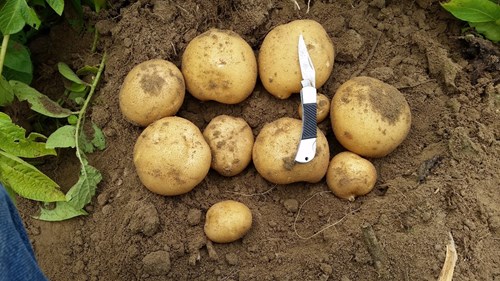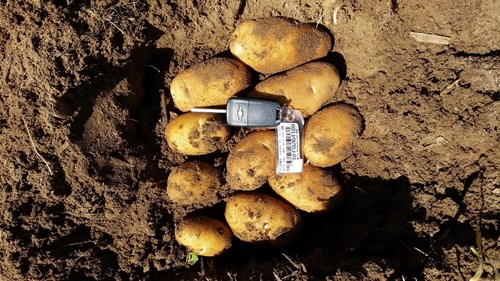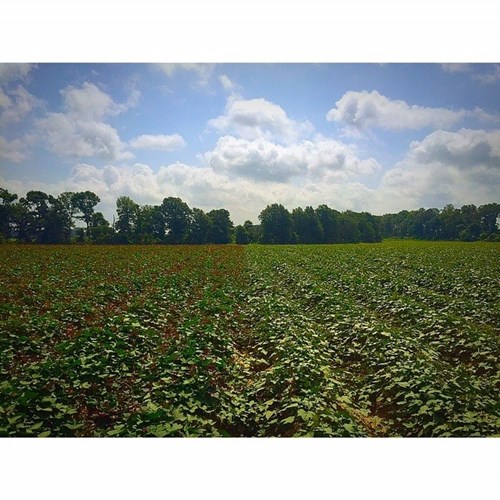Digging: Not all potatoes are created equally
At Black Gold Farms we grow potatoes and lots of them, but they are not all the same. In any one year we will grow more than 20 different varieties of potatoes (Irish potatoes, whites) and 5 or more varieties of Sweet potatoes. Now this does not include all the varieties we grow in small test plots, that help us identify new varieties for the future. Those number in the hundreds.
Why so many? What is the difference?
To answer this, we really have to understand what is the end use of the potato going to be. Really that means; what do our customers want and or need from the potato?
Potatoes for Chips
Chip customers want a potato that has high starch content and when fried is nice and white in appearance. For this we need chipping varieties that will be mostly round with a very light smooth skin, preferably the size of a baseball. We also delivery all of ours directly to customer from the field so the quality has to be there from the field and not be affected by the transport as they make their way to the chip factories. Our Southern locations need a variety that will grow fast (100-120 days from planting to harvest) and hold up into the heat of summer. As we move north we get a little more time to grow them (120-150 days) but in the end still need to delivery high quality on every load every day.

Two chip varieties early season Texas

Chip Potatoes in Maryland
Potatoes for French Fries
French fry customers have the same concern as our chip customers, but prefer varieties with a blockier oblong shape enabling to more efficiently produce the type of product they need. These varieties are often called process potatoes and usually have brown russeted (netted) skin on them. These varieties general are indeterminate in their growth and will take more time (145-165 days) to reach maturity resulting in the best quality and yield.

Young Ranger Russets Indiana
Fresh Potatoes
Fresh or Table Stock potatoes for Black Gold Farms are most often Red potatoes, with some yellows and white potatoes grown as well. Like all other segments the variety changes some by region in order for us to get the best quality and yield we can from them. Our goal in growing Fresh potatoes is for them to be just as beautiful on your plate as they were when we dug them up in the field. This is a beauty and taste competition. These varieties will grow for about the length time our chip varieties do, but will not be allowed to grow till the day we dig as chips will. We need to prepare fresh potatoes in a way that the skin on the potato will set, “no skin means no win for us”. To accomplish this, we must kill the vines early enough to allow for the skin setting process to happen.

Reds in Indiana waiting to be harvested
Sweet Potatoes
Sweet potatoes, although they share the name potato they are a very different crop from our other type Potatoes. Now the customers are some of the same, but what they need from them is different and the management practices to grow them changes dramatically as well.
In the Sweet potato world most processed sweets: Fries, baby food, canned, etc. are just the same variety sweet potato we grow for the fresh market. But times change and we are working with our customers to grow certain varieties that are just for processing. These varieties may not fit perfect on the grocery shelf, but have process qualities such as; high sugar contact straight off the field, blockier oblong shape that translates into less waist when cut into fries and flesh color that is attractive in the final product.

Two sweet potato varieties in Louisiana
Fresh Sweet potatoes are a little like our red potatoes, they need to have a solid attractive skin on them. This allows them to store better and is an expected quality aspect our customers. Now the process to achieve this is much different. It is much less about setting the skin in the field and more about the storage process or curing of the sweet potato. The curing process will help to increase the sugar content of the sweet and make the potato much more shelf stable. Most Sweet varieties are going to take 120-150 days to grow, but we are looking for ones that will be faster allowing us to have fresher product sooner to the market.
Roy Morrow, Director of Agronomy at Black Gold Farms


Share